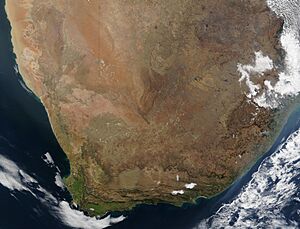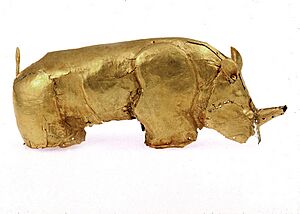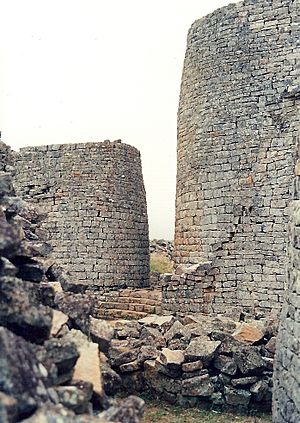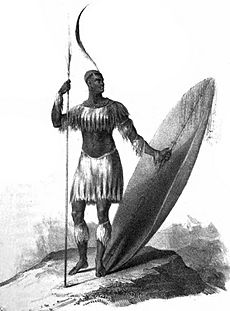History of Southern Africa facts for kids
The history of Southern Africa is a fascinating journey through time! It covers everything from the very first humans to the powerful kingdoms, the time when European countries took control, and finally, when today's nations were formed. Southern Africa is surrounded by Central Africa, East Africa, the Atlantic Ocean, the Indian Ocean, and the vast Sahara Desert. The borders you see on maps today were often drawn by colonial powers, which sometimes split up families and cultures.
Contents
Exploring Southern Africa's Geography
South of the huge Sahara Desert is a drier area called the Sahel. It's like a natural bridge between the desert in the north and the greener Sudanian Savanna to the south. The Sudanian Savanna is a wide belt of tropical grasslands and forests that stretches across Africa, from the Atlantic Ocean all the way to the Ethiopian Highlands.
Understanding Southern Africa's Climate
Around 15,000 years ago, a big change happened. The West African Monsoon brought a lot more rain, turning parts of North Africa into a "Green Sahara." This meant more lakes, wetlands, and grasslands. But between 5,500 and 4,000 years ago, this wet period ended, and the Sahara became a desert again.
Ancient Times: Prehistory of Southern Africa
Long, long ago, at least 170,000 years ago, people in Southern Africa were already cooking and eating plant roots. These roots, from a plant called Hypoxis angustifolia, were found at Border Cave in South Africa. They likely gave early humans energy for their travels.
About 92,000 years ago, people in Malawi were using fire to change their environment. They were smart about how they lived with nature.
Even more amazing, between 65,000 and 37,000 years ago, people in Southern Africa developed the bow and arrow. This was a huge step for hunting and survival!
Early History: The Bantu Expansion
The Bantu peoples, who spoke Bantu languages, started moving from West Africa to other parts of Sub-Saharan Africa. They brought their pottery styles with them. For example, a pottery style called Kalundu might have spread into Southeastern Africa. Other pottery styles, like Urewe from Lake Victoria, also spread along the Indian Ocean coast and through countries like Zimbabwe, Zambia, and Malawi.
Early rock art, painted in red, might have been made between 6,000 and 1,800 years ago. These paintings were done by Khoisan hunter-gatherers in the south, and by Akafula hunter-gatherers in Malawi and Zambia.
Later, Bantu-speaking farmers created white finger-painted rock art. You can find these paintings in parts of Tanzania, Malawi, Angola, Zambia, Zimbabwe, and northern Mozambique, Botswana, and Transvaal. The art in Transvaal was made by Sotho and Venda people. These paintings often showed circles, people, animals, and even ox-wagons. Crocodiles and snakes were common, linked to ideas about rain and fertility. These artworks might have been part of special ceremonies for young people growing up. Some of these paintings are found on items used for telling the future, like drums and masks. This suggests that this art style was important from the Early Iron Age to the Later Iron Age.
Powerful Kingdoms: Post-Classical History
The Kingdom of Mapungubwe
Before the famous Kingdom of Mapungubwe, there was a large settlement called K2. The people of K2, who were likely ancestors of the Shona and Kalanga people, were drawn to the Shashi-Limpopo area. This region was great for farming and had many elephants, which meant valuable ivory. Controlling the trade of gold and ivory made the K2 culture very powerful. Around 1075 CE, the K2 population grew too big for the area, so they moved to Mapungubwe Hill.
The Kingdom of Zimbabwe
The Kingdom of Zimbabwe was a very important and powerful state. It collected taxes from other rulers in the region. This kingdom was made up of over 150 smaller areas, each with its own stone settlement, called a "zimbabwe."
The Kingdom of Mutapa
Mutota's son, Nyanhewe Matope, expanded his father's kingdom into a huge empire. It stretched from Tavara all the way to the Indian Ocean. This empire brought many different peoples together in Southern Africa. They did this by having strong armies and by inviting other states to join peacefully. If a state joined without fighting, its leaders could become part of the Great Council of the Empire. Matope's armies conquered the Manyika kingdom and the coastal kingdoms of Kiteve and Madanda. By the time the Portuguese arrived in Mozambique, the Mutapa Kingdom was the most important state in the region. The empire reached its largest size by 1480 CE, just 50 years after it began.
Other Important Kingdoms
- Kingdom of Butua: The Togwa family ruled the Kingdom of Butua until 1683 CE, before it became part of the Rozvi Empire.
- Torwa Dynasty: The Kalanga people, along with people from Great Zimbabwe, founded the Torwa dynasty at a place called Khami.
- Kingdom of Maravi: Between the 16th and 19th centuries CE, several Maravi kingdoms, like Undi, Lundu, and Kalonga, grew and thrived.
Modern History: Changes and Conflicts
The Merina Kingdom
By the early 1800s CE, the Merina people of Madagascar became very strong. They defeated other tribes like the Bezanozano and Betsimisaraka, and eventually brought the Sakalava kingdom under their control. This is when the name "Merina" became common, meaning "prominent" in the Malagasy language. While some say this was about uniting Madagascar, other tribes saw it as an invasion.
By 1824 CE, the Merina captured the port of Mahajanga on the western coast, showing their growing power. Under King Radama I, the Merina continued to expand their empire, which made their military leaders rich. The British helped the Merina with weapons and training because they wanted to trade with the kingdom.
However, after a treaty with the British ended, the Merina's military actions became more frequent and violent. Between 1828 CE and 1840 CE, over 100,000 men were killed and more than 200,000 were enslaved by Merina forces. Many people escaped, forming groups that resisted the empire. The need for more enslaved people fueled further military campaigns. By the mid-1800s, the Merina Kingdom had almost united all of Madagascar before French colonization in 1895 CE.
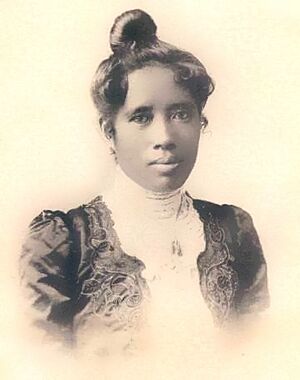
The Rozwi Empire
The Portuguese wrote that the Rozvi Empire had very smart military leaders. They were known for using a "cow-horn formation" in battle many years before the famous Zulu leader Shaka used it in the 1800s CE. Armed with spears, shields, bows, and arrows, the powerful Rozvi took control of the Zimbabwe plateau.
The Ndwandwe Kingdom
The Ndwandwe Kingdom grew in the 19th century CE because of many changes in society, economy, and politics.
The Mthethwa Paramountcy
The Mthethwa people are believed to have come from the Nguni people of northern Natal and the Lubombo Mountains, with their identity forming about 700 years ago. They were among the first groups to leave the African Great Lakes region between 200 CE and 1200 CE. When they arrived in Southern Africa, they settled near modern-day Swaziland before moving to KwaZulu-Natal in the 17th century CE.
The Mthethwa Paramountcy was a group of about 30 Nguni chiefdoms and clans. Unlike the later Zulu Kingdom, it was more of a loose alliance. King Dingiswayo strengthened and expanded the Mthethwa Paramountcy. In the early 1800s CE, he made an alliance with the Tsonga people to the north and began trading ivory and other goods with the Portuguese in Mozambique.
The Zulu Kingdom
Shaka was the son of Senzangakhona, the Zulu King. He was born around 1787 CE. Shaka and his mother, Nandi, were sent away by Senzangakhona. They found safety with the Mthethwa Paramountcy. Shaka became a brave warrior under Dingiswayo, the Mthethwa leader. When Senzangakhona died, Dingiswayo helped Shaka become the chief of the Zulu Kingdom. After Dingiswayo was killed by Zwide, the king of the Ndwandwe, around 1818 CE, Shaka took charge of the entire Mthethwa alliance.
Shaka made many big changes to the Zulu state. He created a well-organized and strong Zulu nation. His most important changes were to the army, using new tactics and weapons. He also made sure that religious leaders supported the state.
Under Shaka's leadership, the alliance survived Zwide's first attack at the Battle of Gqokli Hill in 1818 CE. Within two years, Shaka defeated Zwide at the Battle of Mhlatuze River in 1820 CE. This broke up the Ndwandwe alliance. Some of the Ndwandwe then started attacking other Nguni tribes, causing a huge movement of people called Difaqane or Mfecane. Many people died during this time, and large areas became empty. By 1822 CE, Shaka had built an empire covering about 80,000 square miles.
The Kingdom of Mthwakazi
Mthwakazi is the traditional name for the Ndebele people and their kingdom, located in what is now Zimbabwe. Today, "Mthwakazi" is often used to refer to the people living in the Matebeleland Province of Zimbabwe.
The Slave Trade
Sadly, Southern Africa was also affected by the Indian Ocean slave trade and the Atlantic slave trade. Many people were captured and forced into slavery, which had a terrible impact on communities.
The Colonial Period
In 1652 CE, the Dutch East India Company set up a trading post near the Cape of Good Hope. Their goal was to support sea trade between Europe and Southeast Asia. This outpost grew into Cape Town and became the Dutch Cape Colony. The British took control of this colony twice, first in 1795 CE and then permanently in 1806 CE during the Napoleonic Wars. The colony then became a British possession until the Union of South Africa was formed in 1910 CE.
The establishment of the Cape Colony marked the start of the colonial period in Southern Africa. It became a base for the "Scramble for Africa" in the 1880s, when European powers rapidly took control of African lands. This period also saw the creation of the Boer republics after the Great Trek in 1836 CE. During this time, new people, technologies, plants, and animals arrived in Southern Africa, and the existing African kingdoms began to decline.
The Scramble for Africa
The "Scramble for Africa" was a period in the late 19th century when European countries quickly divided up almost all of Africa among themselves. They drew borders and established colonies, often without considering the local people or their cultures.
The Post-Colonial Period
After the colonial period, many African nations fought for and gained their independence. This led to the formation of the countries we know today in Southern Africa. This time was about building new nations and dealing with the lasting effects of colonialism.
Genetic History of Southern Africa
Scientists study DNA to learn about how people moved and mixed in the past. In Southern Africa, studies show that people from the Bantu expansion mixed with other African groups as they moved south.
Ancient DNA Discoveries
Ancient DNA from three hunter-gatherers from the Later Stone Age shows they were similar to today's Khoisan-speaking hunter-gatherers. Before the Bantu migration, herders from East Africa also moved into Southern Africa, as shown by ancient DNA from Botswana.
DNA from four Iron Age Bantu farmers shows different movements. Two earlier farmers had DNA similar to the Tsonga people and Venda people. Two later farmers had DNA similar to the Nguni people. This tells us that the Bantu migration involved many different groups moving and mixing with the Khoisan-speaking peoples.
South Africa Discoveries
At Doonside, in South Africa, an ancient individual from about 1,910 to 2,296 years ago carried a specific type of DNA called haplogroup L0d2.
At Champagne Castle, in South Africa, an individual from about 282 to 448 years ago carried haplogroup L0d2a1a.
These DNA studies help us understand the deep history of human movement and connections in Southern Africa.
|
See also
- List of kingdoms in Africa throughout history#Southern Africa



